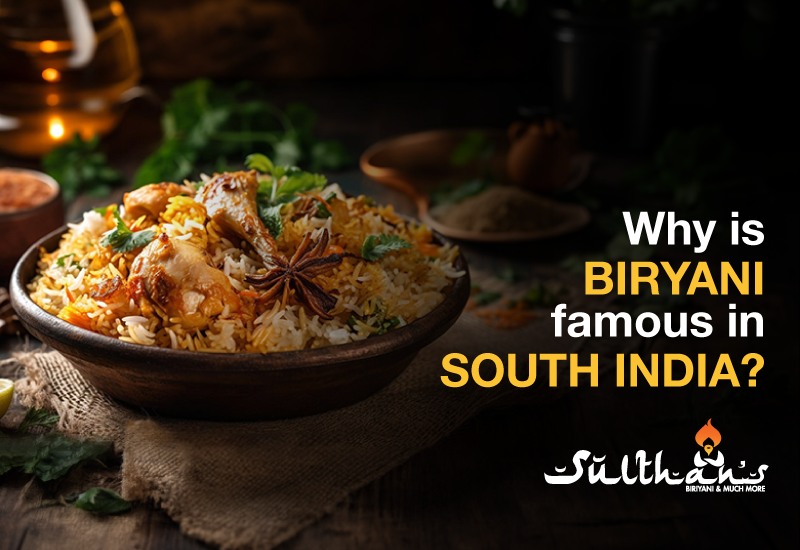Historical Roots Of Biryani
The word “Biryani” holds so much significance in our lives. Before knowing why, let’s rewind and walk down the lane to find the historical roots of biryani.
The story begins centuries ago in ancient Persia. Back then, Persians created a delicious mix of rice and meat enriched with aromatic spices and named it “biryan”. The traders and travellers who loved the dish carried it all along the ancient Silk Road, introducing it to different places.
That’s how biryani made its way to India. When the Persians brought biryani over, Indians embraced it wholeheartedly. This was during the Mughal Empire when Persian influence was strong. Mughals, known for their lavish lifestyle, richness, and flavourful food, took biryani to the next level.
With their royal patronage, biryani got popularised all across India. Different regions put their unique spin on it over time with ingredients and techniques. And that’s why we have many regional varieties of biryani today across the subcontinent.
This blog answers your query, “Why biryani is famous in South India?”
What Makes Biryani A Mouth-Watering Dish?
If you wonder why there’s so much craze around biryani, read further.
Diversity (Different Types)

This diversity ensures there is a perfect biryani for all moods and cravings. Whether diners want the flavours of meat or vegetable and rice-centric options, the versatility satisfies everyone.
Just when you think you’ve tried them all, another regional speciality pops up! Here are some of the most popular South Indian biryanis:
- Hyderabadi biryani
- Kolkata biryani
- Lucknowi biryani
- Thalassery biryani
- Malabar biryani
- Ambur biryani
At Sulthan’s Biryani, you can enjoy lip-smacking woodfire biryani!
Cultural Significance
Beyond its layers of flavour, biryani holds profound cultural importance for South Indians. It has become ingrained in traditions and celebrations over generations.
It is integral to South Indian Muslim identity, cooked for festivals like Eid and Ramadan. Events like weddings and engagements are often centred around grand displays of biryani. Hosting friends and family to plates of the aromatic rice dish is a sign of warmth, love and generosity in South Indian culture.
Biryani fosters bonds between communities and brings people together to share memorable meals.
The royal patronage biryani received for centuries from Muslim rulers of Hyderabad, Awadh and Bengal elevated its prestige. Even today, political leaders and dignitaries gift biryanis as a gesture of hospitality and respect.
Ingredients And Preparation

Now, let us get into what gives biryani its incredible complexity- the ingredients and cooking method. Meat choices vary regionally, but chicken and goat/lamb are most common. Vegetables like potatoes and carrots are also used.
A biryani spice mix called biryani masala forms the flavour foundation. Typical spices include cinnamon, bay leaves, cloves, green cardamom, black pepper and nutmeg. The masala is roasted and ground to unlock maximum flavour. Fresh herbs like coriander and mint are also included.
This results in each rice grain bursting with taste. The meat and rice achieve perfect texture – the meat falls off the bone tender while the rice remains distinct. It is no wonder biryani elicits such passionate love!
Bursting Flavours
Taking the first bite of a well-crafted biryani triggers an explosion of flavours that dance across the palate. Subtle yet vibrant spices blend seamlessly with hearty meat and fluffy rice in a symphony that keeps taste buds entertained from start to finish.
With every mouthful, this dance of spices, meat and grains unfolds anew. Different areas of the tongue are engaged sequentially to keep the experience enjoyable. The balance ensures no one element overwhelms, blending into a greater harmonious whole.
Even as flavours linger and change with every chew, an air of mystery remains – tempting diners to keep eating to unravel new depths with each bite. This multidimensional and constantly evolving nature of biryani’s taste makes it compelling and re-heatable for days.
Nutritional Content
While biryani is often enjoyed as an indulgent treat, it also provides balanced nourishment to fuel the body. The protein and iron from meat add sustaining energy and nutrients for growth and development.
Rice forms the base, contributing carbohydrates that break down slowly for a steady fuel release. Paired with meat, rice also enhances the absorption of minerals like zinc, magnesium and B vitamins.
A variety of spices add layers of antioxidants that support cellular health. Turmeric and cinnamon, in particular, boast anti-inflammatory compounds. Biryani also provides vitamins, including thiamine, riboflavin, niacin and vitamin E. Minerals like potassium, calcium, phosphorus and copper aid nerve and muscle function.
Why Is Biryani Most Loved By South Indians?
South Indians love biryani the most because of the following reasons.
It Is A Hassle-Free Meal

Whether cooking for a weeknight family dinner or entertaining guests, biryani minimises stress since it involves no complexity and all ingredients are layered together in one pot and left to cook undisturbed.
Biryani’s streamlined process from start to finish makes it the ultimate hassle-free dinner option. No wonder it is a favourite for weeknights, events or any time convenience in the kitchen is appreciated.
It’s A Nostalgia Served In A Bowl
A strong emotional connection to biryani comes from childhood memories and family traditions. For many South Indians, the aromas and flavours of their mother or grandmother’s biryani cooking evoke powerful feelings of nostalgia.
It is a comfort food that brings them back to those feelings of home. These memories of time spent with loved ones, of happier periods, get stirred up every time a new bowl of biryani is enjoyed.
For this reason, biryani also shines in its ability to ease homesickness. Whether students living away from home or expat South Indians, that first bite transports them back to familiar family recipes and carefree days. Biryani nourishes nostalgia as much as it does the stomach.
It Doesn’t Necessarily Need A Side Dish
One big advantage of biryani is that it’s truly a complete meal on its own. There’s no question of what sides to prepare or worry over running out of accompaniments. The biryani itself provides that perfect balance of grains, proteins, spices and textures.
For those with less time to cook or clean up, biryani minimises dishes. And it travels well, whether bringing leftovers for lunch or ordering takeout – no fear of sides spilling or getting soggy. This lack of fussiness over the sides is part of what makes biryani such a crowd-pleaser, too.
It’s Perfect For Singles And Terrible Cooks
For anyone living alone or lacking culinary skills, biryani is a lifesaver. As a one-pot meal, it eliminates the hassle of dealing with multiple dishes that can overwhelm and intimidate those new to cooking.
Biryani also forgives imperfections – leeway in measurements and preparation means even terrible cooks can produce delicious results.
Leftover biryani is also a boon, keeping meals interesting for days. The flavours deepen over time, and individual grains reheat beautifully without becoming soggy. This means less takeout temptation and more home-cooked nutrition for busy schedules.
It’s Biryani- no reasons needed!

When it comes down to it, South Indians love biryani simply because it’s biryani!
There’s just something about that perfect blend of spices, the aromatic rice cooked to tender perfection and the melt-in-your-mouth meat.
Now you know what they say- the way to a South Indian’s heart is through their stomach.
At the end of the day, does biryani really need an explanation for why it’s loved? No, it’s biryani! That’s reason enough right there.
Why Choose Sulthan’s Biryani To Satisfy Your Cravings?
If you’re looking for a delicious meal that makes you feel like you’re part of the family, you’ve come to the right place! Sulthan’s Biryani’s expert chefs create delectable dishes over a classic woodfire, giving you an authentic food experience.
Whether you are looking for a special occasion, a home gathering, or simply looking for a comfort meal, Sulthan’s Biryani is sure to leave a lasting impression. Its team of professionals carefully curates and customises meals and plans to meet customer satisfaction at the forefront.
Conclusion
If you are still wondering why biryani is famous, it is simple because it is more than just food. It is straight-up an emotion!
It is not just about the taste. Biryani brings people together. The whole process from prepping to sharing plates- it builds community. It is a sign of love and hospitality to feed others this bomb dish.
So, for South Asians, biryani represents tradition, identity, and nostalgia, and it is an emotion that connects us to family, heritage and all the good times. That is why biryani will always have a special place in our hearts!
Frequently Asked Questions (FAQs)
1). What makes biryani so special?
Biryani is so special because it is more than just a delicious meal and an explosion of flavours nourishing the body and soul. The layered rice dish evokes nostalgia, comfort, and cultural identity for South Asians. With its versatility and ability to bring people together, biryani has secured a treasured place in hearts and traditions across South India.
2). Why biryani is so popular in India?
Biryani is extremely popular in India because it is a complete and flavorful one-pot rice dish that satisfies everyone. The various regional styles of biryani developed across India cater to diverse tastes and preferences, ensuring that biryani remains the favourite celebratory food and comfort meal for many Indians.
3). How did biryani become famous?
Biryani became famous in South India during the Mughal era when Hyderabad was established as the capital of the Golconda Sultanate. Over time, as Muslim traders introduced biryani recipes from Central Asia and Persia, they blended with local South Indian cooking styles and ingredients to become the beloved regional biryanis enjoyed widely today.
4). What is the most popular biryani?
The most popular biryani variant in South India is Hyderabadi biryani. It is renowned for its aromatic basmati rice and tender meat infused with spices. The signature dum cooking technique, which involves cooking the meat and rice together over a slow fire sealed with a crust, gives it a distinct flavour, making it the best-known version of biryani across India.
5). Which language is biryani from?
Biryani originated in Persia, which is now modern-day Iran. The Persian word “biryan” refers to a rice-based dish cooked with meat. Traders and travellers brought this recipe from Persia along the Silk Road, introducing it to India during the Mughal era, which later became “biryani”.




